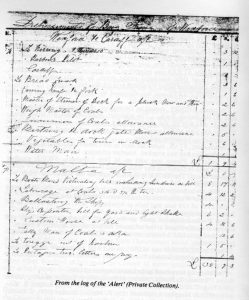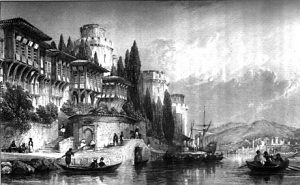From Wexford to Odessa

The story is of a voyage to Odessa on the Black Sea in the late 19th century.By Nicky Rossiter.
The Alert commanded by Captain Patrick Cogley sailed from Wexford port on June 12th 1866 and arrived at Soulinah on the Black Sea on 14th Day of November 1866. This tale is adapted from the ships log kept by Laurence Murphy, Mate.
On June 18th 1866 the crew were preparing from 5 a.m. with the intention of sailing at 7.00. At that hour the Steamboat came alongside and towed the ship to the ballast ground. Crew members Brady, Greene and Clancy were reported as off duty but onshore without liberty. The crew were employed at learning new gear such as braces, halyards etc.
Later the ship was towed out of dock in weather that was “squally with rain, thunder and lightning.” The crew got the gib boom out and the studding sail booms on the yards.
At 9 a.m. they weighed anchor and made sail and by 6 p.m. they were abreast of The Nash. They stowed the fore topsail and the flying gib. The weather had grown “thick and hazy” and they were tacking when required.

On Thursday July 12th they sailed west from Cardiff towards Malta with crew employed scrubbing the paint work. On Monday the 16th they were sailing South West by South. They noted two sails in sight steering to the south. People were “employed in sundry jobs”.
On the following day the log reports people employed “picking the bread, the small from the large.” and “overhauling the spare canvas or sails that were below”.
Some days later they were “scraping the mast”.
On Thursday July 26th at 10.30 they observed to the north of Cape Saint Vincent’s ten sails in company. At noon the Cape was a point on the port bow. (This is in Portugal’s Algarve region).
A week later on August 2nd they “passed The Thomas English with her fore topmast gone”.
On Monday the 6th. there was lightning reported out of the NW Quarter and the crew were employed making mats.
Next day they observed the Seven Capes under their lee. The crew members were enlarging the lower studding and making a flying gib out of an old gib.
On Thursday August 9th Galetta (possibly Valetta) Island bore south at a distance of 15 miles and by Saturday the 11th at noon Gazar bore SE by E at a distance of 20 miles.
At 6 p.m. they were in Malta Harbour and the pilot came alongside and ordered them into the Quarantine Harbour where they put up the quarantine flag at 8 p.m. as they finished mooring and stowed the sails.
They remained there until Monday the 13th on which day they unmoored ship and moved around the grain harbour and moored in the Ropewalk Street at 95 Store. At 9 a.m. they got orders to haul to 33 Store. They did so and moored her there.
On Thursday August 16th 1866 in a moderate breeze from the westward and sultry weather they commenced to discharge 80 tons of coal weighed out.
They had employed two hands in place of Clancy and Duggan. Clancy went to the hospital to be treated for “a cut he got in the side ashore the evening before” and Duggan was off duty with “a cut in the arm received ashore at the same time from the same foreigners”. The coals were weighed by a “distillars” against the captains wishes as there were no English weights to be had.
On Sunday the 19th at 8 p.m. Brady and Green “came aft drunk and gave abusive language after being ashore without liberty.” Laurence Duggan was at work next day but Michael Brady was off duty “from the effects of some beaten received on shore from some American Sailors.”
By Wednesday 22nd they had finished discharging coal with a total of 360 tons.
Next day they got the “long boat in spars lashed” the water was filled and the ballast trimmed. They finished the ballast 10 feet aft and 9 feet fore. Brady returned to his duty to-day.
On Friday 24th in calm weather calm they unmoored ship and got her down to take on a few tons of ballast. The pilot left the ship at noon about 6 miles of harbour.
On Wednesday 29th at 8 p.m. they observed a light on the north end of the island of Cerigo (in the Ionian Islands) and at 4 a.m. they passed the south end of the island as they “could not get through the Sound”.
On Monday September 2nd. people were up “working ship through the Sound”. At noon they were “dodging in the Gulf if Latalia close to the Dora Passage heading towards Constantinople. September 8th at 9 a.m. the steamboat came alongside to tow them round Point Niagra. At 2 p.m. it let them go to make sail and at 7 p.m. they “came abreast of Fisherman’s Point on the Europe Side.”
Next day at noon they were “close up with Galopoli and at 8 p.m. were about 12 miles to the westward of Marmoria Island.
On Thursday the 13th they came to at the back of Suragly (Seraglia) Point and they stowed the sails. Early next morning they hove up and the steam boat towed them out into the Black Sea with a moderate breeze. It let them go on the Bospherous at noon. The day ended with a fresh breeze and clear weather and crew employed matting the holds between decks.
A week later at 8.30 p.m. they observed Soulinah Light bearing North West. Next morning at 8 they tacked in for the pier and received the pilot on board. The Alert moored in Soulinah at 11 a.m.
On Friday 21st. at 4.30 in the afternoon they finished the ballast and commenced to get the hold ready for cargo. By midnight the mats were all laid and ready to take in the cargo. The loading lasted until 8 P.M. on Monday and then they began trimming the load. Some hands were busy bringing water to the boat “as it is salty where we are lying”. Others secured the fore hold. They were ready to sail but it was “blowing strong from the NE and a heavy Sea on the Bar with no chance of attempting out over it.” Even on Friday the 28th there was still a “heavy sea on the bar and pilot would not take us out.”
Next day the steamboat towed them out into the Black Sea. They made all sail and set the Port Topmast and Studding sail.
On Monday October 1st., 1866 a dark and hazy day with light showers they observed the lights of the Bospherous bearing SSW.
By Thursday the 4th they were sailing “from Soulinah towards Wexford Bay.” People were employed scraping the mast and tarring the rigging as well as painting the long boat and repairing the mainsail.
On Friday November 2nd at 4.45 p.m. the log reported that they “passed a Brig dismasted and waterlogged called “The Fred. H. Parker” of Hartlepool.
On Monday 12th at 2 p.m. they observed the Mettle (Metal?) Man bearing N/NE at a distance of 12 miles and at 6 p.m. saw the Conning-beg ship. Next day they “squared away from the Tuskar” and at 7.30 “in the South Sheer the wind fell calm went around to the north.” as they were “in the south bay squally with rane”.
On Tuesday 13th at 5 a.m. they finished the loading of ‘The Topaz’ about 165 tons which lightened the ship to a 11 ft. 1 inch aft and 10 ft. 7 inch fore. At 9 a.m. ‘Taylor Nailor’ came alongside and commenced immediately to work and at 3 p.m. they finished loading her.

Next morning at 8 the steamboat towed ‘The Alert’ in. At 9 they were on the bar where they “just stopped for a few minutes” and at 10 were up at the quay “and left her by to a single anchor until night to moor her”. At 6 p.m. they finished the mooring of the ship “abreast of the office and pumped ship when finished the Log.
Among the supplies and charges recorded at home and abroad were corn costing 5/ = and eggs 8/= as well as a carving knife and fork, sail needles and fish hooks. They paid out for trimming coal and an allowance to the “Weigher and Tipper”. A “man washing down deck” got 2/ =. Ships Chandlers bill including sundry expenses, expenses on shore for two dinners and a “Present to Tallyman of Coals”.
Towage through the Bospherous cost £7-0-0
Posting two letters, one registered cost 1/4 and “Rushon (Russian?) Bill of Health 5/= at Constantinople.
They also record purchasing one case of gin, onions, soft bread and cabbages as well as fish and “small paints”. Sending a Telegram cost £1-0-7
This account is based on the actual written log of the voyage. The original spellings are used throughout and may give rise to confusion on locations. It is interesting to note the lives of these sailors in 1866 on a relatively small vessel visiting ports and meeting peoples that many later Wexford natives into the 1960s would only know fleetingly from school geography lessons. We also find that there was little time for idleness on board with many tasks undertaken during the voyage not that the crew missed out on some fun while on shore leave.
Nicky Rossiter has written 10 books on Wexford history published – most by History Press Ireland and I have broadcast on Sunday Miscellany as well a number of history series on South East Radio.